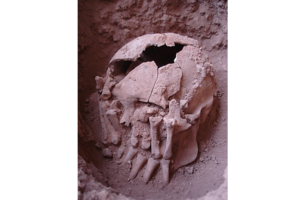Was this 9,000-year-old American decapitated out of kindness?
Archeologists found a skull that had been decapitated in what appears to be a funeral ritual.

The hands of burial 26 were arranged over the face when the anthropologists uncovered the decapitated skull.
Danilo Bernardo
With our history books populated with the likes of Marie Antoinette, Sir Walter Raleigh, and Wildhans von Breitenlandenberg, it's hard for us to to think of beheading as anything other than a punishment.
But a 9,000-year-old American skull might reveal a different perspective.
This once-young man was likely the subject of a ritual decapitation as part of his funeral. Archeologists found the skull in an ancient burial site in Brazil, presenting what might be the earliest known case of decapitation in the Americas. The researchers discuss their findings in a paper published Wednesday in the journal PLOS ONE.
“We would normally see decapitation as something bad, something that’s done as a punitive act or to assure submission of others,” says André Strauss, study lead author and archeologist with the Max Planck Institute for Evolutionary Anthropology. He explains that this perspective, which he calls a Western perspective, assumes that decapitation cannot be good.
But that may not be the case.
Although the skull displays marks where the head was cut from the body, the specimen, dubbed Burial 26, provides evidence to counter theories that the deceased was being punished. Burial 26 was likely kin to the local community and was not strung up as a trophy.
There’s more. The skull was carefully set in its resting place with some company: Burial 26’s hands.
Like the skull, the hands had not been carelessly tossed into a pit. Instead, they cover the man’s face in a seemingly deliberate way.
He wasn’t protecting his face from attack. One of the severed hands rested over each side of his face. The left hand covered his right side of his face, with fingers pointing up and the right hand pointed down as it covered the left side of his face.
“This suggests to us that this burial had an important visual component. This was supposed to be seen by others of the community,” says Mr. Strauss. “We believe that this is also compatible with this scenario for rituals that was surrounding this decapitation. It was intended to be seen, it was careful.”
Perhaps Burial 26 was displayed for relatives to honor their dead brother, says Strauss. But, he cannot guess why. “Archeologists, we can reconstruct behavior, but we cannot reconstruct mental state. I don’t ever know what those guys were thinking.”
The intriguing hand placement wasn’t the only behavioral clue for the archeologists.
Before this discovery, dominant theories about decapitation included punishment or a display of power in the form of trophy heads.
But the young man’s skull showed no signs of display. “A trophy head usually has drill holes where you put something to carry the thing,” says Strauss. “If it’s a trophy head, you want to carry it around.”
Furthermore, Burial 26 appeared to be related to the other individuals found at the dig site. The researchers examined kinship in two ways.
Without DNA to analyze, the scientists used cranial measurements to infer genetic similarities. According to previously established standards, Burial 26 was similar enough to his skeleton companions to suggest they were of the same community.
The scientists also employed strontium analysis to compare Burial 26’s isotopic signature to those in neighboring graves. “This allows you to figure out where someone had their childhood,” Strauss says. For example, “If you grow up in Texas, you have a different strontium signature than if you grow up in New York.”
Again, the scientists found a match.
Burial 26 was one of 37 individuals found at the Brazilian site called Lapa do Santo. Of those, at least nine show similar mortuary processes, says Strauss. The archeologists believe that these bodies were all buried by the same people.
The skeletons had all been similarly altered. In one, the legs were cut. Another’s teeth had been pulled out. One set of bones had even been burned.
“What’s linking all these burials is the fact that they were reducing the corpse,” Strauss says. He suggests that that reduction was significant in the funeral rituals of those people.
“Just as when someone is dying now in society, there are several things that must be done,” as mortuary rituals, says Strauss. “10,000 years ago, in East-Central Brazil, what had to be done was to reduce the body to proceed with the funerary rituals.”
Previously scientists thought that there were no ceremonies around death in this community. “They had this wrong idea that the highly mobile hunter-gathers would just get rid of the rotten corpse and nothing more sophisticated than that,” says Strauss. In this scenario, these people dug simple, shallow graves and moved on.
But, “those groups were way more sophisticated, culturally speaking, than we expected,” he says.
“In East-Central Brazil 10,000 years ago there were some quite sophisticated hunter-gathers living here for about 3,000 years and they were doing sophisticated elaborate things such as these funerary rituals,” says Strauss. And, he adds, “We should give them more credit.”
Burial 26 emerges from continued work at the Lapa do Santo site by a team of experts, led by Strauss. The team hopes to find more clues into the lives and practices of these ancient people, including DNA.


